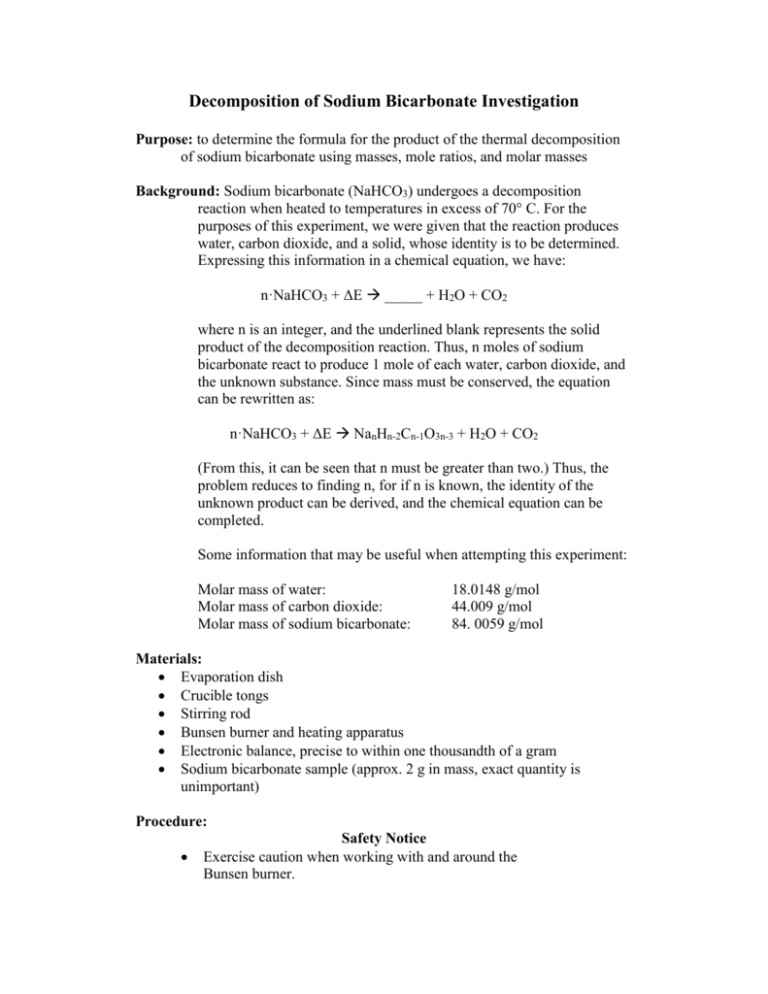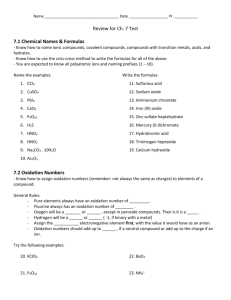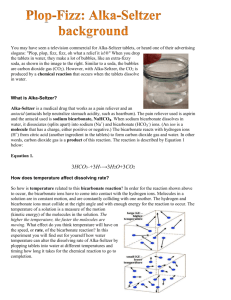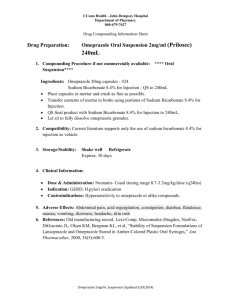File
advertisement

Decomposition of Sodium Bicarbonate Investigation Purpose: to determine the formula for the product of the thermal decomposition of sodium bicarbonate using masses, mole ratios, and molar masses Background: Sodium bicarbonate (NaHCO3) undergoes a decomposition reaction when heated to temperatures in excess of 70° C. For the purposes of this experiment, we were given that the reaction produces water, carbon dioxide, and a solid, whose identity is to be determined. Expressing this information in a chemical equation, we have: n·NaHCO3 + ΔE _____ + H2O + CO2 where n is an integer, and the underlined blank represents the solid product of the decomposition reaction. Thus, n moles of sodium bicarbonate react to produce 1 mole of each water, carbon dioxide, and the unknown substance. Since mass must be conserved, the equation can be rewritten as: n·NaHCO3 + ΔE NanHn-2Cn-1O3n-3 + H2O + CO2 (From this, it can be seen that n must be greater than two.) Thus, the problem reduces to finding n, for if n is known, the identity of the unknown product can be derived, and the chemical equation can be completed. Some information that may be useful when attempting this experiment: Molar mass of water: Molar mass of carbon dioxide: Molar mass of sodium bicarbonate: 18.0148 g/mol 44.009 g/mol 84. 0059 g/mol Materials: Evaporation dish Crucible tongs Stirring rod Bunsen burner and heating apparatus Electronic balance, precise to within one thousandth of a gram Sodium bicarbonate sample (approx. 2 g in mass, exact quantity is unimportant) Procedure: Safety Notice Exercise caution when working with and around the Bunsen burner. When heating a porcelain vessel with the Bunsen burner, gently wave the burner from side to side for a slow, even heating. Be careful when handling hot glassware or porcelain; it will not appear hot. Safety goggles should be worn at all times in the lab. 1. Measure the mass of the evaporation dish using the electronic balance, and record this mass. 2. Pour the sodium bicarbonate sample into the evaporation dish, and measure their combined mass using the balance. Record this mass, and calculate the mass of the sodium bicarbonate sample by subtracting the mass of the evaporation dish from the combined mass of the dish and the sample. 3. Break up any large chunks in the sodium bicarbonate sample using the stirring rod. 4. Heat the sodium bicarbonate in the evaporation dish using the Bunsen burner. While heating, take periodic measurements of the sample’s mass. 5. When, after two consecutive such measurements, the sample’s mass remains constant, remove the sodium bicarbonate from heat. This means that the sodium bicarbonate has undergone complete thermal decomposition and the produced water and carbon dioxide have evaporated away. 6. Measure and record the final combined mass of the evaporation dish and the residual substance. From here, analysis proceeds as outlined in the results section. Results: Mass of evaporation dish: 45.906 g Mass of evaporation dish with sodium bicarbonate: 46.769 g Mass of sodium bicarbonate sample: 46.769 g - 45.906 g = 1.863 g Heating Time (minutes) 0 … 18 21 24 Combined mass (evaporation dish with sodium bicarbonate) (grams) 47.769 ... 47.110 47.081 47.097 Final combined mass: 47.104 g Final sample mass: 47.104 g – 45.906 g = 1.198 g 1 mol Amount of NaHCO3 in original sample: 1.863 g ∗ 89.0659 g = 0.022 mol Now, according to what we know about the decomposition reaction of sodium bicarbonate, n moles of NaHCO3 decompose to produce 1 mole of the unknown substance (as well as one mole of each H2O and CO2). This implies that 1 mole of NaHCO3 decomposes to produce 1/n moles of the unknown substance, or more generally, m moles of NaHCO3 decompose to produce m/n moles of the unknown substance, where m is a real number. Thus, we know that our final sample after heating contains 0.022/n moles of the unknown solid. Also by looking at the decomposition reaction, we can see that the unknown product has molar mass equal to (NaHCO3 )𝑛 − (H2 O) − (CO2 ) g/mol Where(NaHCO3 ), (H2 O), and (CO2 ) represent the molar masses of sodium bicarbonate, water, and carbon dioxide, respectively. Substituting known values for these placeholders, we see that the molar mass of our unknown substance in terms of n is (84.0059)𝑛 − (18.0148) − (44.009) g/mol 84.0059𝑛 − 62.0238 g/mol We now have expressions for both the molar mass and the amount in moles of our unknown substance. The product of these two quantities is equal to the mass of the substance, which was measured to be 1.198 g. So, to find n, we can solve the below equation describing the relationship between the unknown solid’s mass and molarity: 1.198 g = 0.022 mol g ∗ (84.0059𝑛 − 62.0238) 𝑛 mol 1.198 g = (0.022 ∗ 84.0059 − 0.022 ∗ 62.0238 )g 𝑛 0.022 ∗ 62.0238 g = (0.022 ∗ 84.0059 − 1.198) g 𝑛 𝑛 1 1 1 = 0.022 ∗ 62.0238 g 0.022 ∗ 84.0059 − 1.198 g 𝑛= 0.022 ∗ 62.0238 g 0.022 ∗ 84.0059 − 1.198 g 𝑛 = 2.09 ≈ 2 (n must be an integer) Conclusion: This experiment was essentially a problem-solving challenge; it asked the experimenter to determine the identity of the product of the thermal decomposition of sodium bicarbonate. To do this, the mass of a sample of sodium bicarbonate was measured before and after it underwent the decomposition reaction. These masses and other information regarding molar mass and molar ratios were used to complete the given chemical equation describing the reaction. From the experimental data, it was determined that the value of n in the provided chemical equation is 2. Thus, the chemical equation can be completed as follows: (2)·NaHCO3 + ΔE Na2H2-2C2-1O3(2)-3 + H2O + CO2 2NaHCO3 + ΔE Na2CO3 + H2O + CO2 That is to say, 2 moles of sodium bicarbonate decompose into one mole of each sodium carbonate, water, and carbon dioxide at or above 70° C. In the reaction observed in this experiment, the water and carbon dioxide escaped into the atmosphere immediately following the reaction, leaving the solid sodium carbonate as a remnant. This result is keeping with the accepted literature on the decomposition reaction of sodium bicarbonate. The accuracy of the measurements made in this experiment was relatively 2.09−2 g high; the percent relative error in the final calculation of n was 2 g ∗ 100 = 4.5%. It is to be expected that our approximate value for n be slightly greater than the theoretical value, as the primary source of error in this experiment should be one’s inability to completely decompose the sodium bicarbonate sample. Even after extensive heating, one will only be able to procure a slightly impure sample of sodium carbonate from the sodium bicarbonate, with a mass slightly greater than expected (as not all of the water and carbon dioxide bonded within the sodium bicarbonate would have evaporated away). Indeed, the theoretical mass of the sodium carbonate product was 1.166 g, whereas its empirical mass was 1.198 g, 1.198−1.166 corresponding to a percent error of 1.166 ∗ 100 = 2.7%. Noting that n is inversely proportional to the difference of the mass of the sodium bicarbonate sample and the mass of the sodium carbonate product, we see that as the mass of the product increases, the aforementioned difference decreases, and thus n increases. Other potential sources of uncertainty include the added mass of atmospheric water adhering to the evaporation dish and the limited precision of the electronic balance used in the experiment, though the error introduced by the latter is small compared with the magnitude of the quantities being measured. As for the former, water adhering to the dish before heating would contribute to the combined mass of the dish and the sodium bicarbonate sample. When the dish was heated, this excess water would have evaporated away, decreasing this combined mass, and making it appear as if more mass was lost during the decomposition reaction than was actually the case. The fact that the empirical mass of the sodium carbonate product was greater than the theoretical mass would imply that this was not a significant source of error in this experiment.







